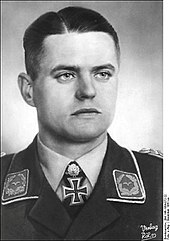Otto Albert Bernhard White

Otto Albert Bernhard Weiß (born September 25, 1907 in Breslau ; † August 19, 1955 in Kiel ) was a German officer in the police and air force in World War II . At the end of the war, Weiß, who is considered to be the founder of aerial tank hunting, was a colonel .
Life
White joined the police on April 15, 1926 . In 1931 he became a police lieutenant . On October 1, 1934, Weiss moved to the Luftwaffe , which was being established, as a first lieutenant . From October 1934 to October 1936 he worked there as a technical officer (TO) in a close-up reconnaissance squadron. He then served as a captain in the staff of Jagdgeschwader 134 "Horst Wessel" until July 1938 . From July to September 1938 he was employed in Fliegertruppe 40. In October 1938, Weiß changed to Lehrgeschwader 2 .
Second World War
During the German attack on Poland in September 1939, Weiss in Group II of the Lehrgeschwader flew 2 low-flying attacks with a Henschel Hs 123 . On September 13th and 30th, 1939 he received the Iron Cross 2nd and 1st class. In the western campaign , the II. Group flew numerous missions under their group commander Weiß in the formation of Sturzkampfgeschwader 1 in the II. Fliegerkorps (Jagdführer 2). The group around Weiß excelled in the destruction of 40 French tanks in the Cambrai area . For the achievements of his Sturzkampfgruppe Weiss received the Knight's Cross of the Iron Cross on May 18, 1940 as captain and commander of the II. Group of LG 2 . On the same day he was mentioned in the Wehrmacht report. On July 1, 1940, White was promoted to major .
From June 21, 1941, he was used again as group commander of Group II of Lehrgeschwader 2 in the Eastern campaign . During the fighting for Kalinin , white earned the nickname "The Lion of Kalinin".
At the turn of the year 1941/1942, the II. Group of LG 2 was converted into part of the newly established battle squadron 1, whose first Commodore White became. On December 31, 1941, Hitler was given the Knight's Cross to White by Hitler at the Führer Headquarters . The award was spread propaganda . It was the first award of the oak leaves to an air force attack pilot. By the summer of 1942, Weiß developed into the founder of tank hunting from the air. In June or July 1942, Weiß rose to become stage manager for battle and destroyer aviators. A position that he fulfilled after Lenfeld / Thomas published it until November 1942. Obermaier mentions November 1943 as the end of this activity.
According to Lenfeld / Thomas, from December 1942 to February 1943, Weiß was in command of the test command for anti-tank combat. Here, Hans-Ulrich Rudel tested the “Kanonenvogel” Ju 87G at the Rechlin test center . From February 1943, Weiß was in command of the white tank hunting command named after him . This command was set up in Bryansk . From June to December 1943 he was the inspector of the attack aircraft. Here white was promoted to colonel on November 1, 1943. He was then from December 1943 to March 1944 head of an airfield commission. From April 1944 to January 1945 he acted as Fliegerführer Eismeer (renamed Fliegerführer 3 from June 1944).
Different statements are available for the last months of the war. According to Lenfeld / Thomas, Weiß is said to have been employed in the staff of Air Fleet 6 under Colonel General Robert Ritter von Greim until May 1945 . According to Obermaier, on the other hand, Weiss was a pilot in the Danzig area from January to May 1945 , and later in the Czech Republic , which had been occupied since March 1939 , the so-called Protectorate of Bohemia and Moravia . By the end of the war, Weiß had completed over 500 enemy flights.
Otto Weiß died on August 19, 1955 after a serious illness.
literature
- Ernst Obermaier: The Air Force Knight's Cross bearers. Stuka and attack aircraft 1939–1945. Dieter Hoffmann Verlag, Mainz 1976.
- Erwin Lenfeld, Franz Thomas: The oak leaves 1940-1945. Weilburg-Verlag, Wiener Neustadt 1983, 2nd edition, ISBN 3-900-100-07-1 .
- John Ward: Hitler's Stuka Squadrons. The Ju87 at War 1936-1945. Motorbooks International, St. Paul, MN, 2004, ISBN 978-0760319918 .
- John Weal: Air Force Battle Groups . Osprey Publishing, Oxford 2003, ISBN 978-1841766089 .
- Franz Thomas with the assistance of Günter Wegmann: Die Eichenlaubträger 1940–1945. Biblio-Verlag, Osnabrück 1997, ISBN 978-3764825133 .
Individual evidence
- ↑ a b Thomas / Wegmann p. 424.
- ↑ a b c d e f g h i j k l m n o p q r s t u v Obermaier p. 54.
- ↑ a b c Thomas p. 427.
- ↑ Ticino p. 340.
- ↑ a b Veit Scherzer : Knight's Cross bearer 1939–1945. The holders of the Iron Cross of the Army, Air Force, Navy, Waffen-SS, Volkssturm and armed forces allied with Germany according to the documents of the Federal Archives. 2nd Edition. Scherzers Militaer-Verlag, Ranis / Jena 2007, ISBN 978-3-938845-17-2 , p. 775.
- ↑ Weal p. 35.
- ↑ Ticino p. 329.
- ↑ a b c d e f g h Lenfeld / Thomas p. 71.
- ^ Ward p. 178.
- ^ Ward p. 180.
- ↑ Ticino p. 313.
| personal data | |
|---|---|
| SURNAME | White, Otto Albert Bernhard |
| ALTERNATIVE NAMES | White, Otto |
| BRIEF DESCRIPTION | German officer, most recently Colonel in the Air Force in World War II |
| DATE OF BIRTH | September 25, 1907 |
| PLACE OF BIRTH | Wroclaw |
| DATE OF DEATH | August 19, 1955 |
| Place of death | Kiel |
